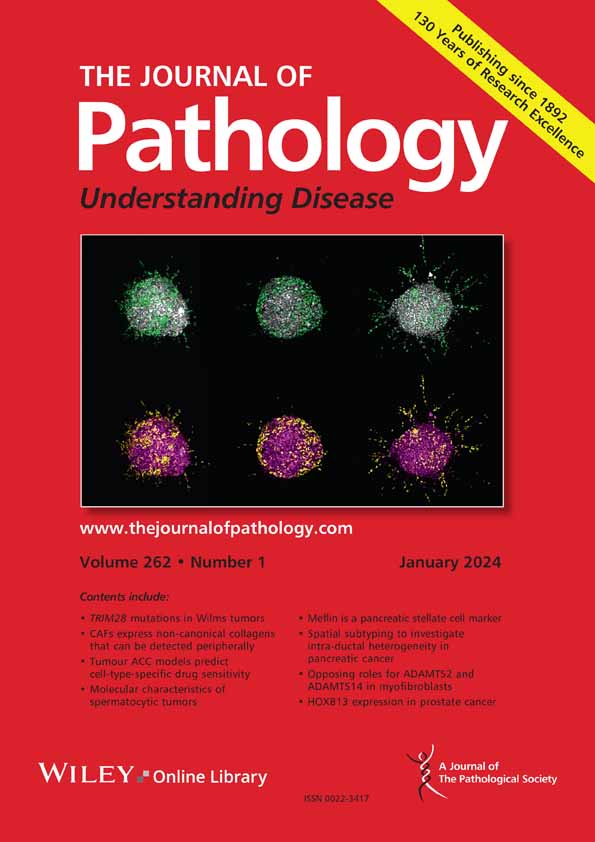下载PDF
{"title":"DNA methylation patterns are influenced by Pax3::Foxo1 expression and developmental lineage in rhabdomyosarcoma tumours forming in genetically engineered mouse models","authors":"Wenyue Sun, Stephen M Hewitt, Hollis Wright, Charles Keller, Frederic G Barr","doi":"10.1002/path.6386","DOIUrl":null,"url":null,"abstract":"<p>Rhabdomyosarcoma (RMS) is a family of phenotypically myogenic paediatric cancers consisting of two major subtypes: fusion-positive (FP) RMS, most commonly involving the <i>PAX3</i>::<i>FOXO1</i> fusion gene, formed by the fusion of paired box 3 (<i>PAX3</i>) and forkhead box O1 (<i>FOXO1</i>) genes, and fusion-negative (FN) RMS, lacking these gene fusions. In humans, DNA methylation patterns distinguish these two subtypes as well as mutation-associated subsets within these subtypes. To investigate the biological factors responsible for these methylation differences, we profiled DNA methylation in RMS tumours derived from genetically engineered mouse models (GEMMs) in which various driver mutations were introduced into different myogenic lineages. Our unsupervised analyses of DNA methylation patterns in these GEMM tumours yielded two major clusters, corresponding to high and no/low expression of <i>Pax3</i>::<i>Foxo1</i>, which mirrored the results for human FP and FN RMS tumours. Two distinct methylation-defined subsets were found for GEMM RMS tumours with no/low <i>Pax3</i>::<i>Foxo1</i> expression: one subset enriched in <i>Pax7</i> lineage tumours and a second subset enriched in myogenic factor 5 (<i>Myf5</i>) lineage tumours. Integrative analysis of DNA methylation and transcriptomic data in mouse and human RMS revealed a common group of differentially methylated and differentially expressed genes, highlighting a conserved set of genes functioning in both human RMS models and GEMMs of RMS. In conclusion, these studies provide insight into the roles of oncogenic fusion proteins and developmental lineages in establishing DNA methylation patterns in FP and FN RMS respectively. © 2025 The Author(s). <i>The Journal of Pathology</i> published by John Wiley & Sons Ltd on behalf of The Pathological Society of Great Britain and Ireland. This article has been contributed to by U.S. Government employees and their work is in the public domain in the USA.</p>","PeriodicalId":232,"journal":{"name":"The Journal of Pathology","volume":"265 3","pages":"316-329"},"PeriodicalIF":5.2000,"publicationDate":"2025-01-15","publicationTypes":"Journal Article","fieldsOfStudy":null,"isOpenAccess":false,"openAccessPdf":"https://onlinelibrary.wiley.com/doi/epdf/10.1002/path.6386","citationCount":"0","resultStr":null,"platform":"Semanticscholar","paperid":null,"PeriodicalName":"The Journal of Pathology","FirstCategoryId":"3","ListUrlMain":"https://pathsocjournals.onlinelibrary.wiley.com/doi/10.1002/path.6386","RegionNum":2,"RegionCategory":"医学","ArticlePicture":[],"TitleCN":null,"AbstractTextCN":null,"PMCID":null,"EPubDate":"","PubModel":"","JCR":"Q1","JCRName":"ONCOLOGY","Score":null,"Total":0}
引用次数: 0
引用
批量引用
Abstract
Rhabdomyosarcoma (RMS) is a family of phenotypically myogenic paediatric cancers consisting of two major subtypes: fusion-positive (FP) RMS, most commonly involving the PAX3 ::FOXO1 fusion gene, formed by the fusion of paired box 3 (PAX3 ) and forkhead box O1 (FOXO1 ) genes, and fusion-negative (FN) RMS, lacking these gene fusions. In humans, DNA methylation patterns distinguish these two subtypes as well as mutation-associated subsets within these subtypes. To investigate the biological factors responsible for these methylation differences, we profiled DNA methylation in RMS tumours derived from genetically engineered mouse models (GEMMs) in which various driver mutations were introduced into different myogenic lineages. Our unsupervised analyses of DNA methylation patterns in these GEMM tumours yielded two major clusters, corresponding to high and no/low expression of Pax3 ::Foxo1 , which mirrored the results for human FP and FN RMS tumours. Two distinct methylation-defined subsets were found for GEMM RMS tumours with no/low Pax3 ::Foxo1 expression: one subset enriched in Pax7 lineage tumours and a second subset enriched in myogenic factor 5 (Myf5 ) lineage tumours. Integrative analysis of DNA methylation and transcriptomic data in mouse and human RMS revealed a common group of differentially methylated and differentially expressed genes, highlighting a conserved set of genes functioning in both human RMS models and GEMMs of RMS. In conclusion, these studies provide insight into the roles of oncogenic fusion proteins and developmental lineages in establishing DNA methylation patterns in FP and FN RMS respectively. © 2025 The Author(s). The Journal of Pathology published by John Wiley & Sons Ltd on behalf of The Pathological Society of Great Britain and Ireland. This article has been contributed to by U.S. Government employees and their work is in the public domain in the USA.
DNA甲基化模式受Pax3::Foxo1表达和基因工程小鼠横纹肌肉瘤肿瘤形成的发育谱系的影响。
横纹肌肉瘤(Rhabdomyosarcoma, RMS)是一个表型性肌源性儿科癌症家族,由两种主要亚型组成:融合阳性(FP) RMS,最常见的涉及PAX3::FOXO1融合基因,由配对盒3 (PAX3)和叉头盒1 (FOXO1)基因融合形成;融合阴性(FN) RMS,缺乏这些基因融合。在人类中,DNA甲基化模式区分了这两种亚型以及这些亚型中与突变相关的亚型。为了研究导致这些甲基化差异的生物学因素,我们分析了来自基因工程小鼠模型(GEMMs)的RMS肿瘤中的DNA甲基化,其中将各种驱动突变引入不同的肌源谱系。我们对这些GEMM肿瘤的DNA甲基化模式进行了无监督分析,得出了两个主要簇,对应于Pax3::Foxo1的高表达和无/低表达,这反映了人类FP和FN RMS肿瘤的结果。在没有或低Pax3::Foxo1表达的GEMM RMS肿瘤中发现了两个不同的甲基化定义亚群:一个亚群富集于Pax7谱系肿瘤中,另一个亚群富集于Myf5谱系肿瘤中。对小鼠和人类RMS的DNA甲基化和转录组学数据的综合分析揭示了一组共同的差异甲基化和差异表达基因,强调了一组在人类RMS模型和RMS的gem中都起作用的保守基因。总之,这些研究提供了致癌融合蛋白和发育谱系在分别建立FP和FN RMS DNA甲基化模式中的作用。©2025作者。《病理学杂志》由John Wiley & Sons Ltd代表大不列颠和爱尔兰病理学会出版。这篇文章是由美国政府雇员贡献的,他们的工作在美国属于公有领域。
本文章由计算机程序翻译,如有差异,请以英文原文为准。






 求助内容:
求助内容: 应助结果提醒方式:
应助结果提醒方式:


